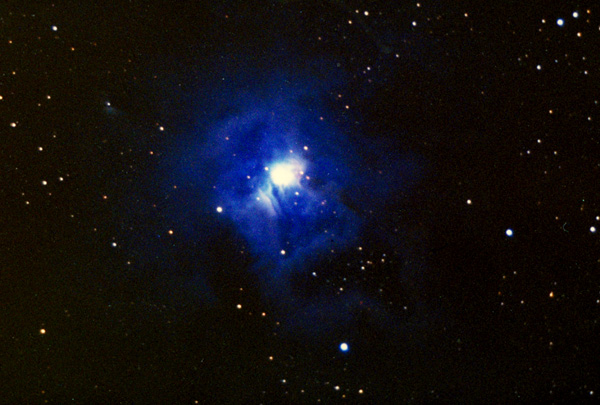
|
Reflection Nebula:
| Readings: Schneider & Arny: Unit 72 |
| (Audio Lecture) |

Often there is found a blue haze around bright, hot stars. This haze is called a reflection nebula and is caused by scattering of blue light off a background cloud of dust. The most famous is the Pleiades (UKS 18, see below), a cluster of young stars in front of a dust cloud.
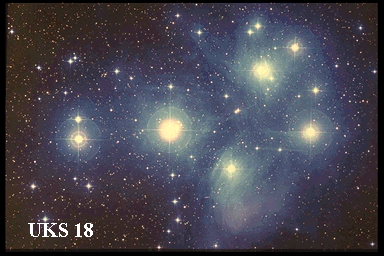
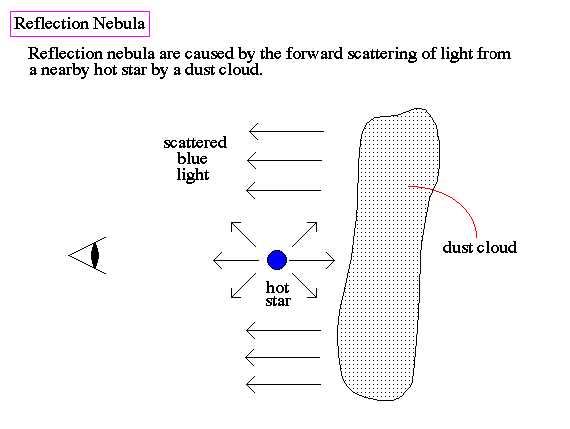
Remember that only the blue component of a star's light is scattered, so the reflection will look bluer than the original star.
Emission nebula look dense, but they are actually thinner than the best vacuum in any laboratory on the Earth. To see this consider the typical density, ρ, from the mass and size of a nebula such that
where M is the mass of the nebula and V is the volume of the nebula.
Notice that it is not how dense a nebula is to detect it, but what is its cross section. Since a nebula is so thin, you basically can see through its core. thus, it is not the volume density at the surface that determines how bright a nebula is, but rather the total number of atoms through the line of sight into the nebula. This is called the cross section, σ, and is expressed as
where L is the length or depth of the nebula.
Masers:
Near regions of star formation are often found powerful sources of microwave radiation, called OH or H2 masers. The radiation from newborn stars causes collisions with the molecules and `pumps' them into excited energy states. Some of these energy states are meta-stable, meaning that they will only transition downward when stimulated by a passing photon. The electromagnetic field of the passing photon causes the excited electron to transition downward emitting another photon of the same energy and wavelength. This is the process behind the laser.
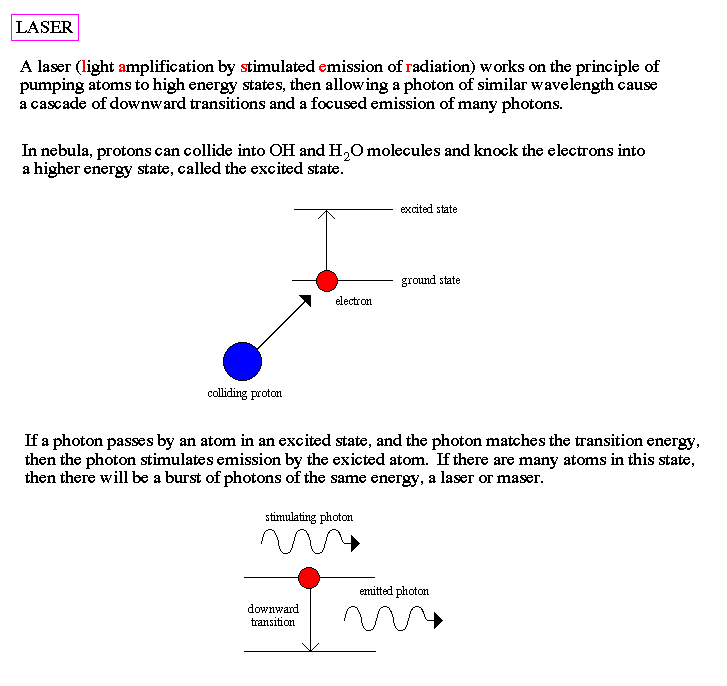
If many molecules in the cloud are pumped to their excited states, then one photon can cause a downward transition of billions of molecules. The released radiation would have a particular wavelength signature instead of being spread out in a thermal spectrum.
HII regions:
Once stars are formed in the center of a molecular cloud, the stars will emit large amounts of UV radiation and heat the cloud. The gas will ionize and become an HII region, a region of ionized hydrogen (HII) surrounded by cooler, neutral hydrogen (HI).
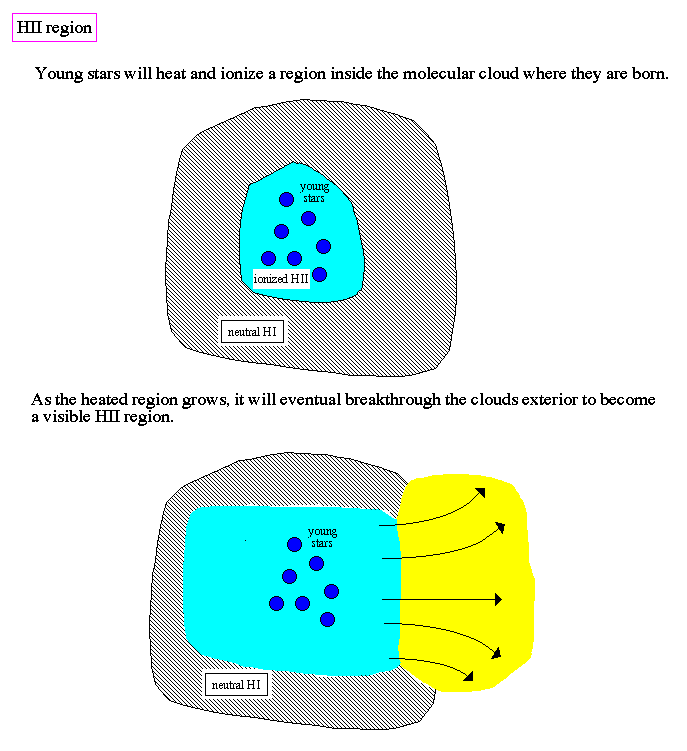
The largest example of an HII region in the sky is the Orion Nebula.
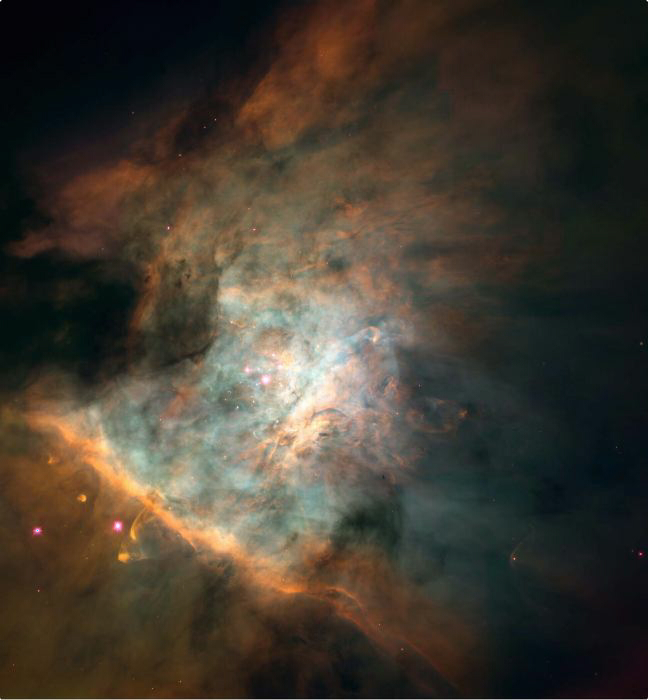
The size of the HII region is directly proportional to the number of UV photons emitted to ionize the gas. You can increase the number of UV photons by either have large mass stars or simply more stars. The glow from an HII region is the recombination of ionized hydrogen, so the size of an HII region is simply the point in space where the rate of recombination equals the rate of photoionization from the central stars. This region is called a Stromgren sphere and is a useful method of calculating the number of hot O and B stars that are produced in the Galaxy by measuring the sizes of HII regions (i.e. the current star formation rate).
Also found in bright HII regions are new stars, and with them supernova. Supernova explosions over thousands of years will send shock waves back into the molecular cloud where they were born from. This will cause compression in the cloud and enhance the formation of even more new stars as shown below.
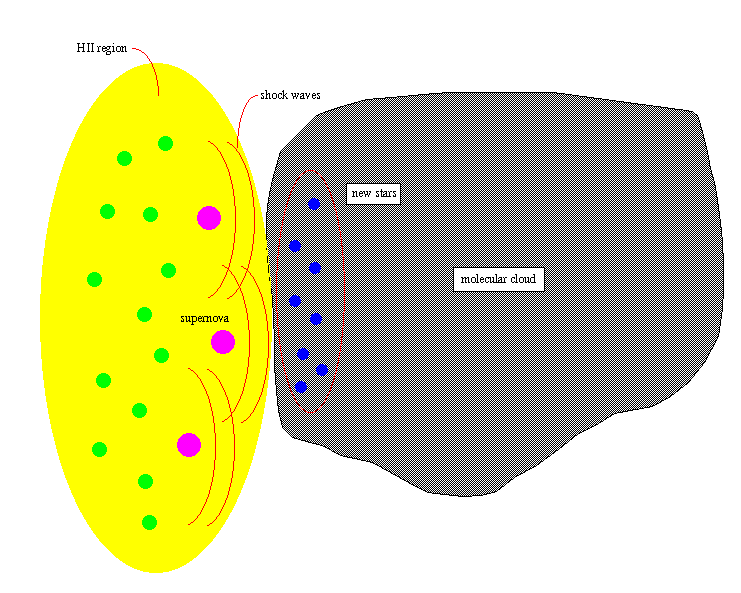
The style of star formation will lead to the spiral patterns we see in galaxies, where star formation travels along the dense clouds found in the spiral arms.
Planetary Nebula:
Hotter and more compact than HII regions are planetary nebula, which got their names cause they look like distant fuzzy planets in old telescopes. Since planetary nebula are the ejected envelopes of AGB stars, the regions around them are empty, unlike the dense clouds around HII regions. The planetary nebula are heated solely from the interior AGB core. Thus, planetary nebula offer a unique chance to watch the interaction of radiation and low density gas.
Most planetary nebula are spherically symmetric shells with some icicle shapes on the inner edge of the outrushing shell, such as IC 3568. The green color is from emission lines of oxygen. If the original star was rotating, then a disk can form with holes along the long axis for radiation to escape, such as NGC 6826, NGC 7009 and NGC 3918. `Fliers' develop where there is a leak of UV light.
Often a remnant disk shell or old solar system will form a disk near the star. In this case, the expanding gas moves faster out the poles of the solar system to develop a dumbbell shape as in Hubble 5. The strangest case is where the core star has a hotspot not aligned with the rotation axis. This hotspot could be ejected charged particles which are falling back onto the magnetic poles of the stars. The result is a beam or jet of UV radiation which will paint helix shaped wobbles on the planetary nebula, as in NGC 5307.

|
|

|